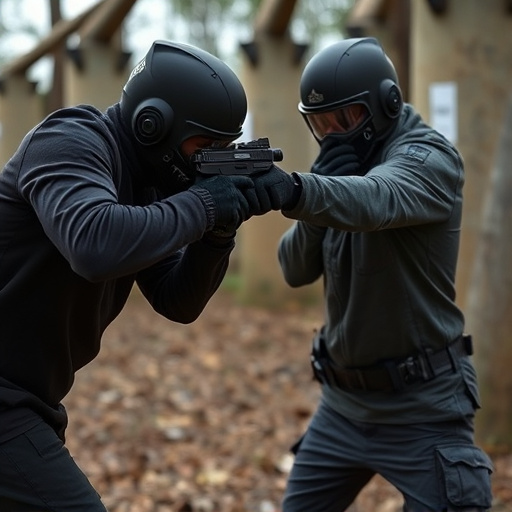Proper pepper spray storage in cool, dry, and dark conditions is crucial for maintaining its potency and effectiveness. The shelf life typically ranges from 2-5 years, depending on brand and formulation. Extreme temperatures, direct sunlight, and moisture can degrade the active ingredient, capsaicin, so storing it away from heat sources and maintaining the seal is essential to ensure safety and readiness for self-defense or law enforcement purposes. Regular inspections and tests are vital for critical applications.
“Uncover the power and intricacies of inflammatory riot control spray dispensers in this comprehensive guide. We delve into the essential aspects of pepper spray, from its chemical composition and effectiveness to crucial storage practices for optimal performance and safety.
Explore factors influencing shelf life, primarily temperature and exposure, and learn responsible maintenance and disposal methods. By understanding these key elements, you’ll ensure these powerful tools remain reliable, safe, and environmentally responsible.”
- Understanding Pepper Spray Basics and Their Composition
- Storage Considerations for Optimal Effectiveness and Safety
- Factors Affecting Shelf Life: Temperature and Exposure
- Maintenance and Disposal: Ensuring Longevity and Responsibility
Understanding Pepper Spray Basics and Their Composition
Pepper spray, a common tool in riot control and self-defense, is a powerful substance designed to temporarily incapacitate individuals through irritation and pain. Its active ingredient, capsaicin, is derived from chili peppers, making it an effective yet non-lethal option for law enforcement and personal protection. Understanding the basics of pepper spray composition is crucial for its proper use and storage.
When it comes to pepper spray storage and shelf life, knowing how to maintain its potency is essential. Typically, these sprays have a shelf life of 2-3 years when stored properly. Exposure to extreme temperatures, direct sunlight, or moisture can degrade the active ingredients. It’s recommended to store them in cool, dry places, away from direct heat sources, and ensure they remain sealed to prevent contamination. Proper storage practices extend not only the spray’s effectiveness but also guarantee its safety for intended use when needed.
Storage Considerations for Optimal Effectiveness and Safety
Proper storage is crucial for maintaining pepper spray’s effectiveness and safety. It should be stored in a cool, dry place away from direct sunlight and heat sources. High temperatures can degrade the active ingredients, reducing the spray’s potency over time. Additionally, keep it out of reach of children and unauthorized individuals to prevent accidental use or misuse.
When storing pepper spray, consider its shelf life—usually 3 to 5 years under optimal conditions. After this period, the spray may lose its strength, making it less effective during emergency situations. Regularly inspect and test your supply to ensure they remain viable. Disposing of expired sprays is essential for safety and should be done according to local regulations.
Factors Affecting Shelf Life: Temperature and Exposure
The shelf life of pepper spray, like many chemical compounds, is significantly influenced by two key factors: temperature and exposure. Extreme temperatures can accelerate the degradation process, leading to a reduction in potency and effectiveness over time. For instance, high heat can cause the active ingredients to break down faster, while low temperatures might solidify or crystallize the contents, making application more challenging.
Additionally, prolonged exposure to light, especially direct sunlight, can also hasten the spoilage of pepper spray. The ultraviolet (UV) radiation from sunlight degrades the chemical composition, resulting in a loss of potency. Therefore, proper Pepper Spray Storage often involves keeping it in a cool, dark place to preserve its shelf life and ensure it remains potent when needed.
Maintenance and Disposal: Ensuring Longevity and Responsibility
Proper maintenance and disposal practices are essential for ensuring the longevity and responsible use of inflammatory riot control spray dispensers, also known as pepper spray. Regular cleaning and storage conditions play a significant role in maintaining optimal performance. It’s recommended to store these devices in cool, dry places, away from direct sunlight or extreme temperatures, as these factors can degrade the active ingredients over time.
When it comes to pepper spray storage and shelf life, manufacturers often provide guidelines for proper handling. Following these recommendations ensures maximum effectiveness. Generally, storing pepper spray in its original packaging helps maintain potency, with shelf lives varying between 2-5 years depending on the brand and formulation. Regular inspection and testing are crucial to confirm the spray’s viability, especially in high-risk or law enforcement settings where quick response times depend on reliable equipment.
Pepper spray, a powerful tool for riot control, requires careful consideration regarding storage and shelf life. By understanding the optimal conditions for preservation and the factors that can reduce its effectiveness, users can ensure the dispenser remains potent and safe for its intended purpose. Regular maintenance and responsible disposal practices are essential to maximize its lifespan, making it a reliable resource in emergency situations. With proper care, pepper spray can serve as an effective deterrent while adhering to safety standards.
